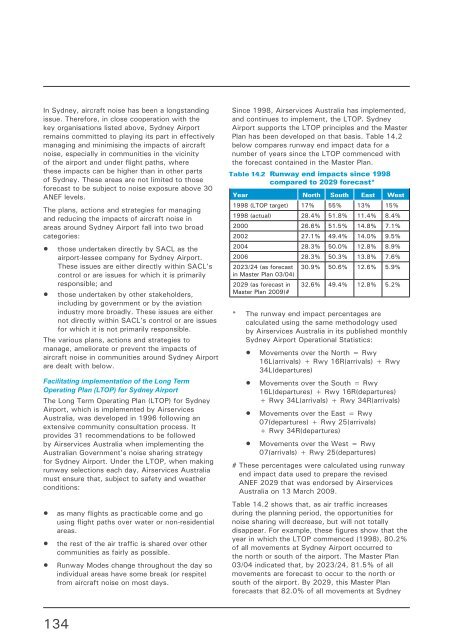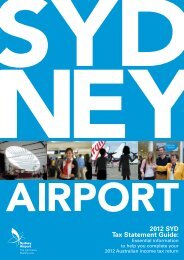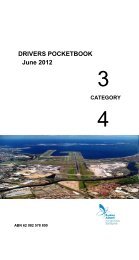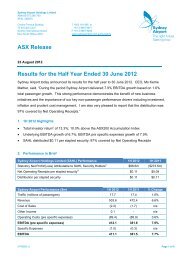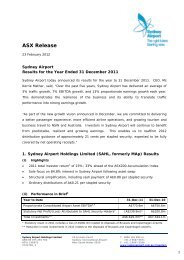Master Plan 2009 - Sydney Airport
Master Plan 2009 - Sydney Airport
Master Plan 2009 - Sydney Airport
You also want an ePaper? Increase the reach of your titles
YUMPU automatically turns print PDFs into web optimized ePapers that Google loves.
In <strong>Sydney</strong>, aircraft noise has been a longstanding<br />
issue. Therefore, in close cooperation with the<br />
key organisations listed above, <strong>Sydney</strong> <strong>Airport</strong><br />
remains committed to playing its part in effectively<br />
managing and minimising the impacts of aircraft<br />
noise, especially in communities in the vicinity<br />
of the airport and under flight paths, where<br />
these impacts can be higher than in other parts<br />
of <strong>Sydney</strong>. These areas are not limited to those<br />
forecast to be subject to noise exposure above 30<br />
ANEF levels.<br />
The plans, actions and strategies for managing<br />
and reducing the impacts of aircraft noise in<br />
areas around <strong>Sydney</strong> <strong>Airport</strong> fall into two broad<br />
categories:<br />
• those undertaken directly by SACL as the<br />
airport-lessee company for <strong>Sydney</strong> <strong>Airport</strong>.<br />
These issues are either directly within SACL’s<br />
control or are issues for which it is primarily<br />
responsible; and<br />
• those undertaken by other stakeholders,<br />
including by government or by the aviation<br />
industry more broadly. These issues are either<br />
not directly within SACL’s control or are issues<br />
for which it is not primarily responsible.<br />
The various plans, actions and strategies to<br />
manage, ameliorate or prevent the impacts of<br />
aircraft noise in communities around <strong>Sydney</strong> <strong>Airport</strong><br />
are dealt with below.<br />
Facilitating implementation of the Long Term<br />
Operating <strong>Plan</strong> (LTOP) for <strong>Sydney</strong> <strong>Airport</strong><br />
The Long Term Operating <strong>Plan</strong> (LTOP) for <strong>Sydney</strong><br />
<strong>Airport</strong>, which is implemented by Airservices<br />
Australia, was developed in 1996 following an<br />
extensive community consultation process. It<br />
provides 31 recommendations to be followed<br />
by Airservices Australia when implementing the<br />
Australian Government’s noise sharing strategy<br />
for <strong>Sydney</strong> <strong>Airport</strong>. Under the LTOP, when making<br />
runway selections each day, Airservices Australia<br />
must ensure that, subject to safety and weather<br />
conditions:<br />
• as many flights as practicable come and go<br />
using flight paths over water or non-residential<br />
areas.<br />
• the rest of the air traffic is shared over other<br />
communities as fairly as possible.<br />
• Runway Modes change throughout the day so<br />
individual areas have some break (or respite)<br />
from aircraft noise on most days.<br />
134<br />
Since 1998, Airservices Australia has implemented,<br />
and continues to implement, the LTOP. <strong>Sydney</strong><br />
<strong>Airport</strong> supports the LTOP principles and the <strong>Master</strong><br />
<strong>Plan</strong> has been developed on that basis. Table 14.2<br />
below compares runway end impact data for a<br />
number of years since the LTOP commenced with<br />
the forecast contained in the <strong>Master</strong> <strong>Plan</strong>.<br />
Table 14.2 Runway end impacts since 1998<br />
compared to 2029 forecast*<br />
Year North South East west<br />
1998 (LTOP target) 17% 55% 13% 15%<br />
1998 (actual) 28.4% 51.8% 11.4% 8.4%<br />
2000 26.6% 51.5% 14.8% 7.1%<br />
2002 27.1% 49.4% 14.0% 9.5%<br />
2004 28.3% 50.0% 12.8% 8.9%<br />
2006 28.3% 50.3% 13.8% 7.6%<br />
2023/24 (as forecast<br />
in <strong>Master</strong> <strong>Plan</strong> 03/04)<br />
30.9% 50.6% 12.6% 5.9%<br />
2029 (as forecast in<br />
<strong>Master</strong> <strong>Plan</strong> <strong>2009</strong>)#<br />
32.6% 49.4% 12.8% 5.2%<br />
* The runway end impact percentages are<br />
calculated using the same methodology used<br />
by Airservices Australia in its published monthly<br />
<strong>Sydney</strong> <strong>Airport</strong> Operational Statistics:<br />
• Movements over the North = Rwy<br />
16L(arrivals) + Rwy 16R(arrivals) + Rwy<br />
34L(departures)<br />
• Movements over the South = Rwy<br />
16L(departures) + Rwy 16R(departures)<br />
+ Rwy 34L(arrivals) + Rwy 34R(arrivals)<br />
• Movements over the East = Rwy<br />
07(departures) + Rwy 25(arrivals)<br />
+ Rwy 34R(departures)<br />
• Movements over the West = Rwy<br />
07(arrivals) + Rwy 25(departures)<br />
# These percentages were calculated using runway<br />
end impact data used to prepare the revised<br />
ANEF 2029 that was endorsed by Airservices<br />
Australia on 13 March <strong>2009</strong>.<br />
Table 14.2 shows that, as air traffic increases<br />
during the planning period, the opportunities for<br />
noise sharing will decrease, but will not totally<br />
disappear. For example, these figures show that the<br />
year in which the LTOP commenced (1998), 80.2%<br />
of all movements at <strong>Sydney</strong> <strong>Airport</strong> occurred to<br />
the north or south of the airport. The <strong>Master</strong> <strong>Plan</strong><br />
03/04 indicated that, by 2023/24, 81.5% of all<br />
movements are forecast to occur to the north or<br />
south of the airport. By 2029, this <strong>Master</strong> <strong>Plan</strong><br />
forecasts that 82.0% of all movements at <strong>Sydney</strong>


